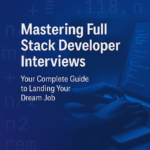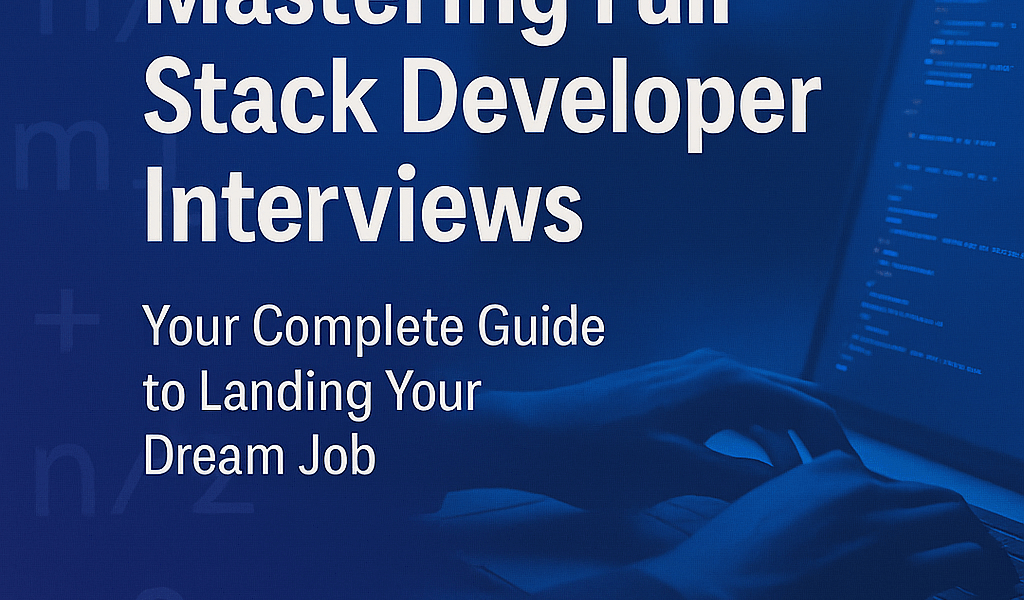
Mastering Full Stack Developer Interviews: Your Complete Guide to Landing Your Dream Job
The tech industry’s demand for versatile full stack developers continues to surge, making these roles both lucrative and competitive. Whether you’re transitioning from a specialized role or starting fresh in web development, understanding what interviewers expect can make the difference between success and disappointment. This comprehensive guide breaks down everything you need to know to excel in your next full stack developer interview.
What Makes Full Stack Development Unique?
Full stack development encompasses both front-end user interface creation and back-end server logic implementation. Unlike specialized developers who focus on one area, full stack developers bridge the gap between user experience and system architecture. This versatility makes them valuable assets to development teams, especially in startups and agile environments where wearing multiple hats is essential.
The modern full stack developer must understand database design, server configuration, API development, user interface creation, and deployment processes. This breadth of knowledge requires continuous learning and adaptation to new technologies and frameworks.
Foundation Level Questions Every Developer Should Master
Core Web Technologies
Understanding the fundamental building blocks of web development forms the cornerstone of any successful interview. Interviewers often start with basic concepts to gauge your foundational knowledge before diving deeper.
HTML and Semantic Structure Modern web development emphasizes semantic HTML that describes content meaning rather than just appearance. Elements like <header>, <nav>, <main>, and <article> provide structure that both browsers and search engines can understand effectively.
CSS and Layout Management The CSS box model remains crucial for understanding how elements position themselves on web pages. Each element consists of content, padding, border, and margin areas. Mastering flexbox and grid layouts enables responsive design that adapts seamlessly across different screen sizes.
JavaScript Fundamentals JavaScript powers interactivity on the web. Understanding variable declarations, function scope, event handling, and DOM manipulation provides the foundation for more advanced concepts. Arrow functions, destructuring, and modern ES6+ features have become standard in contemporary development.
Version Control and Collaboration
Git proficiency is non-negotiable in modern development workflows. Understanding branching strategies, merge conflicts resolution, and collaborative workflows through pull requests demonstrates professional development practices.
Creating meaningful commit messages, understanding when to create new branches, and knowing how to revert problematic changes shows maturity in software development processes.
Intermediate Concepts That Separate Candidates
HTTP Protocol and API Design
Understanding the difference between GET and POST requests goes beyond memorizing definitions. GET requests should be idempotent and safe, meaning repeated requests don’t change server state. POST requests typically create or modify resources and aren’t idempotent.
RESTful API design follows consistent patterns using HTTP methods appropriately. Resource-based URLs combined with proper HTTP status codes create predictable interfaces that other developers can understand intuitively.
Asynchronous Programming Patterns
JavaScript’s asynchronous nature often confuses developers transitioning from synchronous languages. Promises provide cleaner alternatives to callback functions, while async/await syntax makes asynchronous code read more like synchronous code.
Understanding when operations block the main thread versus running asynchronously affects user experience significantly. Long-running operations should never freeze user interfaces.
Database Integration
Connecting applications to databases requires understanding both relational and non-relational database concepts. SQL databases excel at maintaining data consistency and supporting complex relationships. NoSQL databases offer flexibility for rapidly changing data structures and horizontal scaling.
Object-Relational Mapping (ORM) tools like Mongoose for MongoDB or Sequelize for SQL databases provide abstraction layers that simplify database interactions while maintaining type safety.
Authentication and Security
User authentication involves verifying identity through credentials, while authorization determines what authenticated users can access. Session-based authentication stores user information server-side, while token-based systems like JWT keep authentication stateless.
Security considerations include input validation, SQL injection prevention, Cross-Site Scripting (XSS) protection, and secure communication through HTTPS. Understanding these concepts demonstrates professional development practices.
Advanced Topics for Senior Positions
System Architecture and Scalability
Microservices architecture breaks monolithic applications into smaller, independent services. Each service handles specific business logic and communicates through well-defined APIs. This approach enables independent deployment, technology diversity, and better fault isolation.
Containerization using Docker packages applications with their dependencies, ensuring consistent environments across development, testing, and production. Kubernetes orchestrates container deployment, scaling, and management in production environments.
Performance Optimization Strategies
Web application performance affects user experience and business metrics directly. Optimization techniques include:
- Code Splitting: Loading only necessary JavaScript for initial page render
- Image Optimization: Using appropriate formats and compression levels
- Caching Strategies: Implementing browser caching, CDNs, and server-side caching
- Database Optimization: Creating proper indexes and optimizing query performance
Testing Methodologies
Test-Driven Development (TDD) involves writing tests before implementing features. This approach ensures code meets requirements and remains maintainable as applications evolve.
Unit tests verify individual functions work correctly in isolation. Integration tests confirm different components work together properly. End-to-end tests simulate complete user workflows to ensure the entire application functions as expected.
CI/CD Pipeline Implementation
Continuous Integration automates code integration and testing when developers commit changes. Continuous Deployment extends this automation to production releases, reducing manual errors and deployment time.
Modern CI/CD pipelines include automated testing, security scanning, and deployment to multiple environments. Tools like GitHub Actions, GitLab CI, or Jenkins orchestrate these workflows.
Framework-Specific Knowledge
React Ecosystem
React’s component-based architecture promotes reusable UI elements. Understanding JSX syntax, component lifecycle methods, and state management through hooks enables building complex user interfaces.
The virtual DOM optimizes rendering performance by comparing component states and updating only changed elements. This mechanism makes React applications responsive even with complex UIs.
Node.js Backend Development
Node.js enables JavaScript execution outside browsers, making full stack JavaScript development possible. Express.js framework simplifies server creation, routing, and middleware implementation.
Understanding Node.js event loop behavior prevents blocking operations that could freeze server responses. Proper error handling and logging ensure applications remain stable in production environments.
Database Management
MongoDB’s document-based structure suits applications with evolving data schemas. Understanding aggregation pipelines, indexing strategies, and replica sets enables building scalable database solutions.
SQL databases require understanding table relationships, normalization principles, and query optimization. Knowing when to use joins versus denormalization affects application performance significantly.
Behavioral and Problem-Solving Skills
Technical skills alone don’t guarantee interview success. Demonstrating problem-solving approaches, communication abilities, and teamwork experience matters equally.
When presented with coding challenges, think aloud to show your reasoning process. Start with clarifying questions, outline your approach, then implement the solution. Discussing trade-offs and potential improvements shows depth of understanding.
Preparing examples of challenging projects, team collaboration experiences, and learning from failures demonstrates professional growth and adaptability.
Common Pitfalls to Avoid
Many candidates struggle with explaining complex concepts simply. Practice describing technical topics to non-technical audiences to improve communication skills.
Avoid claiming expertise in technologies you’ve only briefly encountered. Interviewers often probe deeper into claimed skills, and superficial knowledge becomes apparent quickly.
Don’t neglect the human side of development. Understanding user needs, business requirements, and team dynamics matters as much as technical proficiency.
Preparing for Different Interview Formats
Technical Screening Calls typically focus on fundamental concepts and high-level system design. Prepare concise explanations of core technologies and your experience with different tools.
Coding Challenges test problem-solving skills and code quality. Practice on platforms like LeetCode or HackerRank, but focus on understanding patterns rather than memorizing solutions.
System Design Interviews evaluate architectural thinking. Practice designing scalable systems, considering database choices, caching strategies, and potential bottlenecks.
Behavioral Interviews assess cultural fit and communication skills. Prepare specific examples using the STAR method (Situation, Task, Action, Result) to describe your experiences.
Staying Current with Industry Trends
Technology evolves rapidly, making continuous learning essential. Follow industry blogs, participate in developer communities, and experiment with new frameworks in personal projects.
Understanding emerging trends like serverless computing, Progressive Web Apps, and WebAssembly demonstrates forward-thinking and adaptability.
Contributing to open-source projects showcases your code quality and collaboration skills while building a portfolio that employers can review.
Final Preparation Tips
Create a portfolio showcasing diverse projects that demonstrate your full stack capabilities. Include both front-end interfaces and back-end APIs, with clear documentation explaining your architectural decisions.
Practice explaining your projects’ technical challenges and solutions. Interviewers often ask about specific implementation details, so refresh your memory on key decisions and trade-offs.
Research the company’s technology stack and business model. Tailoring your responses to their specific needs shows genuine interest and preparation.
Prepare thoughtful questions about the role, team structure, and technical challenges. Interviews are bidirectional conversations where you’re also evaluating the opportunity.
Remember that interviews test communication skills as much as technical knowledge. Clear explanations, active listening, and collaborative problem-solving often matter more than knowing every framework detail.
Frequently Asked Questions
How long should I prepare for a full stack developer interview?
Preparation time varies based on your current skill level and the role’s requirements. Generally, plan for 2-4 weeks of focused preparation. Spend time reviewing fundamental concepts, practicing coding challenges, and building or updating portfolio projects. Consistent daily practice is more effective than cramming.
What’s the most important skill for full stack developers?
While technical breadth is important, problem-solving ability and learning agility top the list. Technology stacks change frequently, but strong analytical thinking and the ability to quickly acquire new skills remain valuable throughout your career. Communication skills are equally crucial since full stack developers often bridge different teams and stakeholders.
Should I specialize in one technology stack or learn multiple?
Start by mastering one complete stack thoroughly (like MERN or LAMP), then expand your knowledge strategically. Deep expertise in one area provides a strong foundation, while broader knowledge helps you make better architectural decisions and adapt to different project requirements.
How do I demonstrate full stack skills without professional experience?
Build comprehensive personal projects that showcase both front-end and back-end capabilities. Create applications with user authentication, database integration, and responsive interfaces. Deploy your projects to cloud platforms and document your development process. Contributing to open-source projects also demonstrates real-world collaboration skills.
What salary range should I expect for full stack developer positions?
Salaries vary significantly based on location, experience level, and company size. Entry-level positions typically range from $60,000-$80,000, while senior roles can exceed $150,000 in major tech markets. Remote work has expanded opportunities beyond geographical constraints, but research market rates for your specific situation.
How important is knowledge of DevOps and deployment?
Modern full stack developers are expected to understand deployment processes, even if they don’t manage production infrastructure directly. Familiarity with containerization, CI/CD pipelines, and cloud platforms makes you more valuable and enables you to take ownership of complete feature development cycles.
What’s the difference between full stack and T-shaped developers?
Full stack developers have broad knowledge across multiple technologies and can work on different parts of applications. T-shaped developers have deep expertise in one area (the vertical stroke) plus broader knowledge in related fields (the horizontal stroke). Both approaches are valuable, but full stack roles typically require more balanced skill distribution.
How do I stay updated with constantly changing web technologies?
Follow reputable tech blogs, subscribe to newsletters like JavaScript Weekly, and participate in developer communities. Focus on understanding underlying principles rather than chasing every new framework. Allocate time for experimental projects where you can explore new technologies without project pressure.
What questions should I ask during the interview?
Ask about the team’s development practices, technology stack decisions, and growth opportunities. Inquire about code review processes, testing practices, and how technical decisions are made. Questions about mentorship, learning resources, and career progression show long-term thinking and commitment.
How do I handle questions about technologies I don’t know?
Be honest about your knowledge gaps while demonstrating learning ability. Explain how you would approach learning the technology, drawing parallels to similar tools you do know. This honesty builds trust and shows self-awareness, which many employers value over false expertise claims.

